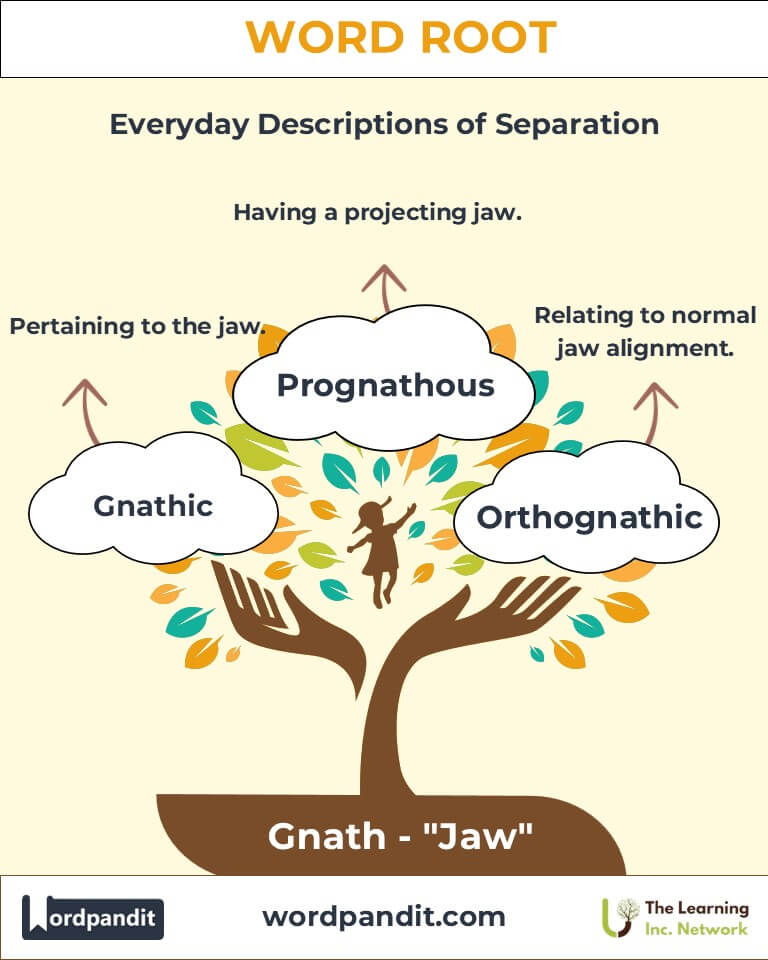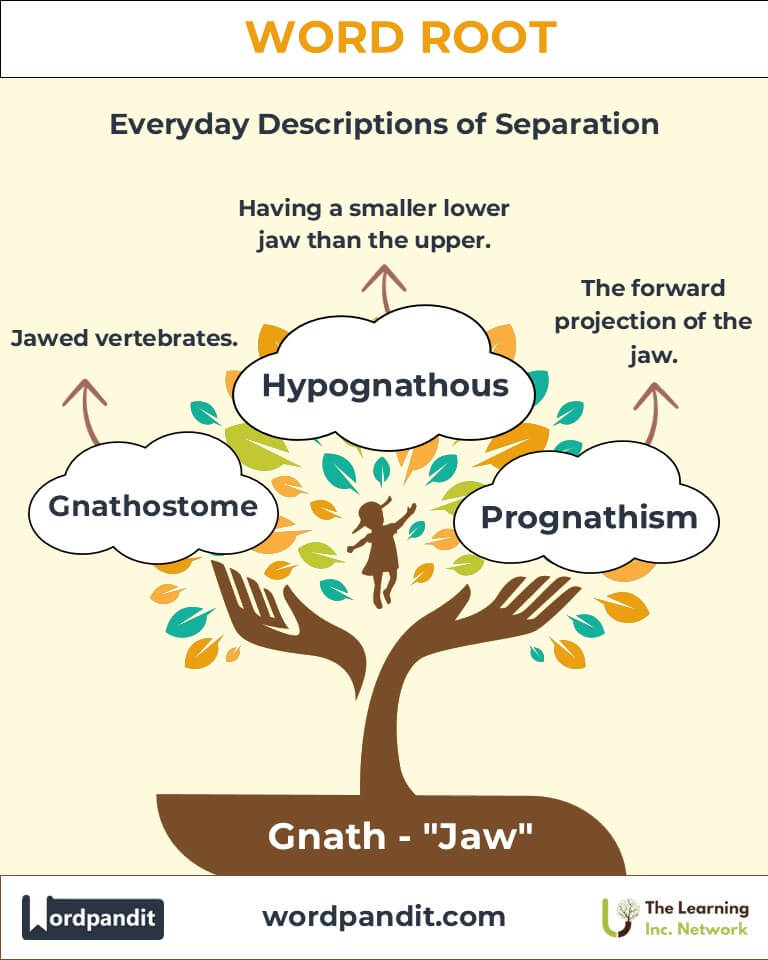Gnath: The Foundation of Jaw-Related Terminology
Dive into the fascinating linguistic root "gnath," originating from Greek and meaning "jaw." From descriptive anatomical terms like "gnathic" to evolutionary insights in "prognathous," the root "gnath" unveils the structure and function of this essential feature in humans and animals alike.

Table of Contents
- Introduction: The Essence of Gnath
- Etymology and Historical Journey
- Mnemonic: Unlocking the Power of Gnath
- Common Gnath-Related Terms
- Gnath Through Time
- Gnath in Specialized Fields
- Illustrative Story: Gnath in Action
- Cultural Significance of the Gnath Root
- The Gnath Family Tree
- FAQs about the Gnath Root
- Test Your Knowledge: Gnath Mastery Quiz
- Conclusion: The Living Legacy of Gnath
Introduction: The Essence of Gnath
The root gnath (pronounced nay-th or guh-nath) carries the weight of biological importance, literally and figuratively. Derived from the Greek word gnathos, meaning "jaw," this root underpins terms that describe jaw-related anatomy and characteristics. Whether in humans or animals, the jaw plays a crucial role in chewing, speaking, and expressing emotions. Words like "gnathic" and "prognathous" explore this root's applications in fields such as medicine, anthropology, and zoology.

Etymology and Historical Journey
The root gnath hails from the Greek gnathos, referring to the jaw. Early studies of vertebrate anatomy and dental structures relied on this term, emphasizing its centrality in descriptions of skeletal frameworks. Over time, the root transitioned into Latin medical texts, solidifying its presence in modern anatomical language. As taxonomy and comparative anatomy developed, gnath became pivotal in describing evolutionary traits, such as jaw projection in species.
Mnemonic: Unlocking the Power of Gnath
Mnemonic Device: "Gnath gives jaws their name, for chewing, roaring, and power untamed."
Picture a mighty lion roaring, showcasing its prominent jaws. The word gnath connects to jaws and strength, helping you associate the root with this essential feature.
Common Gnath-Related Terms
- Gnathic (nay-thik):
- Definition: Pertaining to the jaw.
- Example: "The surgeon focused on the gnathic regions during the reconstruction."
- Prognathous (prog-nay-thus):
- Definition: Having a projecting jaw.
- Example: "Prognathous facial structures are common in many primates."
- Hypognathous (hy-po-nay-thus):
- Definition: Having a smaller lower jaw.
- Example: "Birds like swallows exhibit a hypognathous beak arrangement."
Gnath Through Time
- Ancient Texts: Early Greek anatomists used gnathos to describe jawbones in medical and zoological writings.
- Anthropology: In the 19th century, "prognathism" became a critical term in describing evolutionary differences in human and primate skulls.
- Modern Medicine: Today, terms like "orthognathic" define surgical fields focusing on jaw alignment.
Gnath in Specialized Fields
Medicine
- Orthognathic Surgery: Used to correct facial deformities, ensuring proper alignment of the jaw.
- Prognathism Studies: Addresses conditions where jaw projection affects bite and aesthetics.
Zoology
- Gnathostomes: Examines the evolutionary advantage of jawed vertebrates over jawless counterparts.
- Hypognathous Beaks: Studies bird adaptations for feeding habits.
Dentistry
- Gnathic Alignment: Central to orthodontics and jaw rehabilitation techniques.
Illustrative Story: Gnath in Action
Dr. Elena, a maxillofacial surgeon, encountered a young patient with severe prognathism, affecting both appearance and function. Through a complex orthognathic surgery, she realigned the jaw, restoring not only the patient’s smile but also their confidence. Her work exemplified the practical importance of understanding "gnath"-related terms in medicine.
Cultural Significance of the Gnath Root
The jaw symbolizes strength and determination in various cultures. From totemic animals with powerful jaws like wolves and tigers to idioms like "jaw-dropping," this root echoes resilience and vitality. Anthropological studies of jaw structure continue to inform our understanding of human evolution and cultural development.

The Gnath Family Tree
Related Roots
- Dent- (tooth):
- Example: Dentition - Arrangement of teeth.
- Maxill- (upper jaw):
- Example: Maxillary - Pertaining to the upper jaw.
- Mandibul- (lower jaw):
- Example: Mandibular - Relating to the lower jaw.
- Stom- (mouth):
- Example: Stomatology - Study of the mouth.

FAQs About the Gnath Word Root
Q: What does the root "gnath" mean, and where does it come from?
A: The root "gnath" means "jaw" and originates from the Greek word gnathos. It forms the basis for terms describing jaw-related anatomy, conditions, and evolutionary features in both humans and animals.
Q: What is prognathism, and why is it significant?
A: Prognathism refers to the forward projection of the jaw. It is significant in anthropology and evolutionary biology because it provides insights into dietary adaptations, speech evolution, and the physical traits of ancient human species. It also has clinical importance when addressing misaligned jaws.
Q: What are gnathostomes, and why are they important in biology?
A: Gnathostomes are jawed vertebrates, a group that includes most modern species such as humans, mammals, fish, and birds. Their evolutionary development marked a significant step in vertebrate evolution, enabling more effective feeding strategies and ecological adaptations compared to jawless ancestors.
Q: How does orthognathic surgery improve patient outcomes?
A: Orthognathic surgery corrects misaligned jaws to enhance functions like chewing, speaking, and breathing. It also improves facial aesthetics, boosting patients' confidence and quality of life.
Q: What does "hypognathous" describe, and where is it observed?
A: "Hypognathous" describes a smaller or recessed lower jaw compared to the upper jaw. This trait is commonly observed in certain bird species, such as swallows, where it aids in feeding efficiency and prey capture.
Q: How does the gnath root relate to evolutionary studies?
A: The gnath root is central to understanding the evolutionary significance of jaws. The study of gnathostomes sheds light on how jaw structures diversified to accommodate various feeding mechanisms and ecological niches.
Q: What role does "gnathic alignment" play in dentistry?
A: Gnathic alignment refers to the correct positioning of the upper and lower jaws. In dentistry and orthodontics, achieving proper alignment is crucial for functional occlusion (bite), preventing conditions like TMJ disorders and ensuring overall oral health.
Test Your Knowledge: Gnath Mastery Quiz
1. What does "gnath" mean?
2. Which term describes a projecting jaw?
3. What does orthognathic surgery correct?
4. What are gnathostomes?
5. Which term refers to a smaller lower jaw?
Conclusion: The Living Legacy of Gnath
The root gnath reflects the essential role of jaws in anatomy, evolution, and function. From medical innovations to evolutionary insights, this root continues to shape our understanding of the natural world. As we uncover more about "gnath," we celebrate the intricate design of one of nature’s most vital structures.












